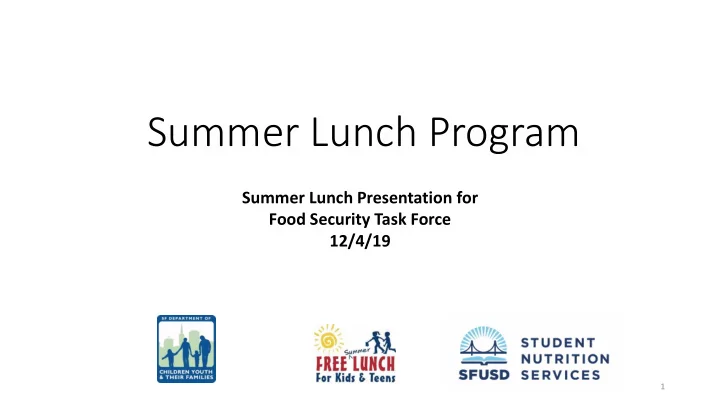

Summer Lunch Program Summer Lunch Presentation for Food Security Task Force 12/4/19 1
Agenda Overview of Summer Lunches • Successes • Data Points • Current Challenges • Next steps • 2
Overview: What is the Summer Lunch Program? • SFUSD and DCYF serves free lunches to youth across San Francisco during summer months • Uses Federally-funded USDA programs – DCYF uses Summer Food Service Program (SFSP) and SFUSD uses Summer Seamless Option (SSO) and National School Lunch Program (NSLP). • Each program has different administrative requirements, but follows similar rules and regulations for service • Over 150+ summer lunch sites across the city • Sponsors coordinate FREE meals • DCYF – lunch and one snack • SFUSD – breakfast and lunch • Open to anyone 18 years and younger across San Francisco • Up to date information available by calling 211, 311, dcyf.org • Currently, there are over 31,000 youth that qualify for FRPM yet only about 17% of all youth enrolled in SFUSD eat summer lunches. 3
How Does the Program Work? ; US Dept of Agriculture Makes the rules; ensures the funding! $$$ paperwork CA Dept of Education Oversees rules; provide the funding paperwork $$$ Revolution DCYF & SFUSD (Sponsor) Community Foods groups such as Coordinate with sites; front program costs; resources $$$ (Food Vendors) Food vendors; monitor sites; FSTF Provides food! site visits, resources paperwork Community Sites/Schools Food Serve food; outreach to community Follow guidelines; coordinate with vendors Healthy food! Safe place to eat!
How Does the Program Work? Terms and Definitions In general, SFSP and SSO uses area eligibility to qualify sites for Summer Lunches. This means • that if a site is located in an attendance zone where 50% or more of their students quality for free/reduced price meals (FRPMs) then the site qualifies. If a site is willing to serve youth in the community as well as those enrolled in their program, • they are an “open” site. Sites only willing to serve youth in enrolled programs are considered “closed”. 5
Successes Leverage resources to provide Summer Lunch Brochure to • every SFUSD campus SFUSD/DCYF hosted a nutrition poster contest to create an • outreach poster that was posted at every open site SFUSD’s partnership with No Kid Hungry • 6
Trend of City-wide Summer Meals Estimated Number of Number of # of Open Average # of Reimbursement Year Lunches sites Sites lunches/day from USDA 2013 297,112 136 n/a 8,500 $960,978.00 2014 306,044 147 n/a 10,400 $947,851.00 2015 340,564 160 131 12,500 $1,123,861.00 2016 364,917 168 120 12,800 $1,237,068.00 2017* 291,664 152 114 9,722 $1,012,074.08 2018* 261,492 155 95 8,716 $928,296.60 2019* 254,351 137 74 8,478 $928,381.15 There is about 31,000 students enrolled in SFUSD qualify for FRPMs yet only 16% of those students eat summer lunches. *Note: • # of open sites in 2013-2014 not available • 2017 data from third-party is not available • 2018 & 2019 shows data for the only two major sponsors – SFUSD & DCYF 7
Summer Lunch Open Sites in San Francisco 2015 vs. 2019 8
Current Challenges • Lack of shared measurement – reporting requirements to USDA/CDE does not meet San Francisco data needs • Eligibility – Changes in SNAP and minimum wage ordinance have made it more difficult for families to apply and qualify for RFPM’s • Number of sustainable sponsors in SF - In 2017, a third-party sponsor (non-SFUSD/non-DCYF) abruptly stopped serving meals. • Sites that were originally served from third-party sponsor had the most issues with compliance • Program Rules – New requirements deter sites from applying and/or qualifying for the program • Restrictions for sites within close distances – less sites quality as “open” • Enrollment forms for closed-enrolled sites 9
Call to Action/Next Steps • Data Collection –A centralized data system can make for better data quality and analysis • Increase funding – to compensate for less federal reimbursements • Dedicate more resources to high-capacity sites – including technical assistance, increase quality programming, and addressing structural needs (equipment, staffing, etc.) • Strategized with partners to think outside the box – we appreciate any possible solutions! 10
Questions? Robin Knox – SFUSD SNS Michelle Kim - DCYF Child Nutrition Programs Manager Health and Nutrition Coordinator 415-749-3604 x 13008 415-934-4838 knoxr1@sfusd.edu Michelle.kim@dcyf.org 11
Recommend
More recommend